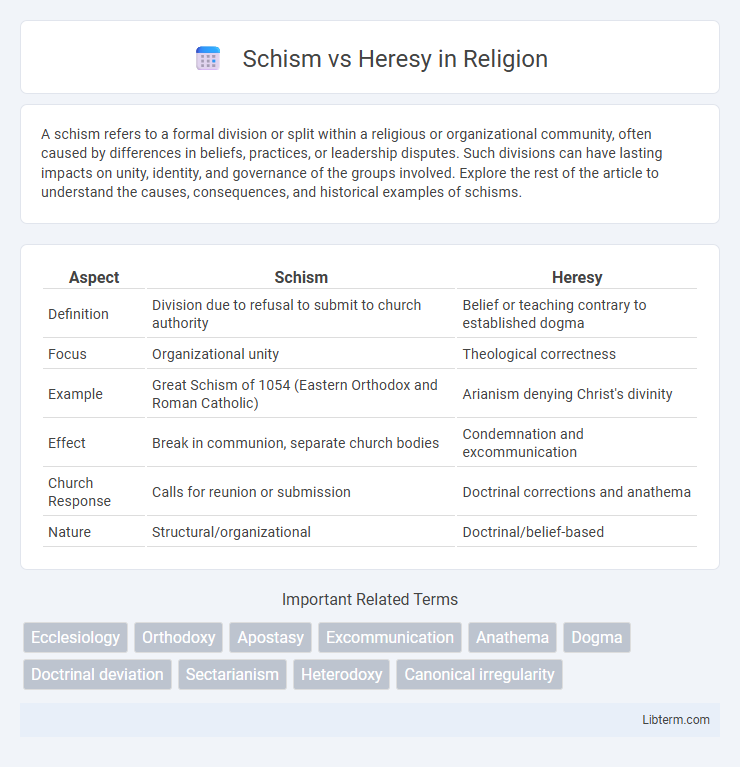A schism refers to a formal division or split within a religious or organizational community, often caused by differences in beliefs, practices, or leadership disputes. Such divisions can have lasting impacts on unity, identity, and governance of the groups involved. Explore the rest of the article to understand the causes, consequences, and historical examples of schisms.
Table of Comparison
| Aspect | Schism | Heresy |
|---|---|---|
| Definition | Division due to refusal to submit to church authority | Belief or teaching contrary to established dogma |
| Focus | Organizational unity | Theological correctness |
| Example | Great Schism of 1054 (Eastern Orthodox and Roman Catholic) | Arianism denying Christ's divinity |
| Effect | Break in communion, separate church bodies | Condemnation and excommunication |
| Church Response | Calls for reunion or submission | Doctrinal corrections and anathema |
| Nature | Structural/organizational | Doctrinal/belief-based |
Understanding Schism: Definition and Origins
Schism refers to a formal division or separation within a religious community due to differences in doctrine, authority, or practice, often leading to the establishment of distinct groups. Its origins can be traced to historical disputes over ecclesiastical authority and interpretation of faith, such as the Great Schism of 1054 between the Eastern Orthodox and Roman Catholic Churches. Understanding schism involves recognizing the role of institutional and theological conflicts that cause communities to break away rather than merely differing in belief.
Heresy Explained: Meaning and Historical Context
Heresy refers to beliefs or doctrines that deviate from established orthodox religious teachings, often leading to condemnation and exclusion from the religious community. Historically, heresy played a critical role in shaping Christian theology, exemplified by early controversies such as Arianism, which challenged the nature of Christ and prompted ecumenical councils to define orthodoxy. The identification and suppression of heresies were essential for maintaining doctrinal unity and authority within the Church throughout history.
Key Differences Between Schism and Heresy
Schism refers to a formal division or split within a religious community due to disagreements over authority or organizational structure, while heresy involves the rejection or distortion of established doctrinal beliefs. Schism affects the unity and governance of the church, whereas heresy challenges core theological truths and teachings. The Council of Nicaea addressed significant heresies by defining orthodox doctrine, contrasting with the Great Schism of 1054, which was a major institutional separation between Eastern Orthodox and Roman Catholic Churches.
Theological Implications of Schism
Schism involves a formal division within the Church resulting from the refusal to submit to ecclesiastical authority, leading to a break in communion rather than a deviation in doctrine. The theological implications of schism emphasize the importance of unity in the Body of Christ, highlighting the Church's role as a visible and spiritual community essential for salvation. Unlike heresy, which entails false teaching and doctrinal error, schism primarily disrupts ecclesial unity without necessarily altering core theological beliefs.
The Consequences of Heresy in Religious Communities
Heresy in religious communities often leads to severe doctrinal fragmentation, resulting in exclusion, excommunication, or persecution of those labeled as heretics. This challenge to orthodox beliefs undermines communal unity and can provoke long-lasting theological disputes, weakening the institution's authority. The social repercussions include mistrust, division, and sometimes violent conflict, fundamentally altering the religious landscape.
Historical Examples of Schism in Christianity
The Great Schism of 1054 marked a pivotal division between the Western Roman Catholic Church and the Eastern Orthodox Church, driven by disputes over papal authority and doctrinal differences. Another significant schism occurred during the Western Schism (1378-1417), where multiple claimants to the papacy fragmented Christendom and challenged ecclesiastical unity. These schisms differ from heresies, as they involve structural and jurisdictional divisions rather than solely doctrinal errors, profoundly impacting the development of Christian denominations.
Notable Cases of Heresy Across Ages
Notable cases of heresy across ages include the Arian controversy in the 4th century, which challenged the divinity of Christ and led to the Nicene Creed's formulation. The Cathar heresy in the 12th and 13th centuries rejected the Catholic Church's doctrines, prompting the Albigensian Crusade. During the Reformation era, Martin Luther's 95 Theses criticized Church corruption, sparking Protestant heresies and significant religious fragmentation.
How Churches Respond to Schism and Heresy
Churches respond to schism by seeking reconciliation through dialogue and efforts to restore unity, often involving councils or synods to address doctrinal disagreements and jurisdictional conflicts. In cases of heresy, churches implement formal processes of investigation, excommunication, or correction to preserve doctrinal purity and protect the faithful from theological errors. Both responses emphasize maintaining communal integrity and doctrinal orthodoxy to uphold ecclesiastical authority and spiritual well-being.
The Role of Authority in Addressing Doctrinal Disputes
Schism arises from a breach in ecclesiastical authority, causing division due to refusal to submit to Church leadership, while heresy involves the propagation of false teachings that distort core doctrines. Church authorities use councils, synods, and official magisterial declarations to resolve heretical controversies, reaffirming orthodox dogma and correcting errors. In contrast, schisms challenge hierarchical unity, prompting disciplinary actions such as excommunication to restore communal cohesion.
Schism vs Heresy: Modern Relevance and Challenges
Schism and heresy continue to influence modern religious dynamics, with schism representing a formal division within a religious community and heresy involving the rejection of core doctrinal beliefs. The challenge lies in addressing these issues while maintaining unity and doctrinal integrity amid increasing pluralism and diverse interpretations. Understanding their distinctions is critical for religious leaders navigating contemporary theological disputes and institutional cohesion.
Schism Infographic

 libterm.com
libterm.com